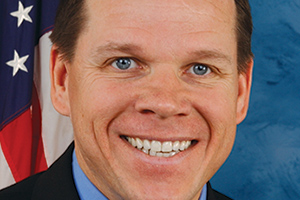Senior Reporter
Connected Vehicle Technologies a Priority For Next Highway Bill, Rep. Graves Says

This story appears in the June 20 print edition of Transport Topics.
Establishing programs that transportation officials and experts may use to devise strategies to reduce congestion through advanced technologies will need to be a part of the next long-term transportation bill, Rep. Sam Graves (R-Mo.) told stakeholders June 9.
Equipping state agencies with enhanced communication applications and boosting funds to augment roadway capacity will serve to alleviate the choke points along freight corridors that impede economic growth, added Graves, who is chairman of the Highways and Transit Subcommittee.
“The average American spends 42 hours per year in traffic,” he said. “That’s unacceptable. And while we can’t always build or spend our way out of congestion, technology can help us use what we have more efficiently and plan a better path, going forward.”
The roundtable with stakeholders, the congressman added, took another step to modernize infrastructure and utilize advantages the private sector offers through technological developments.
Graves indicated he will be laying out the panel’s vision for a new highway bill in the coming months. To identify a sustainable source of funding, he reiterated his intention to collaborate with tax-writing policymakers on the Ways and Means Committee. That panel has jurisdiction over the Highway Trust Fund, an account that relies on revenue accrued from federal fuel taxes.
He added that Republican leaders are considering generating highway dollars through a tax overhaul. Last year, Congress passed a five-year highway bill that became the FAST Act, which authorizes more than $300 billion for projects into roads, bridges and transit systems.
Graves touted the FAST Act for establishing a competitive transportation and congestion management deployment grant program known as FASTLANE. It is intended to promote the use of innovative technologies relying on data and feedback to inform decision-making.
The FAST Act also prompts the Federal Highway Administration, states, local governments and stakeholders to look for ways they can safely and expediently drive the adoption, deployment and delivery of innovative technologies to enhance safety and efficiency.
A group of transportation officials told Graves that cities must proceed with transportation technology developments to ensure the innovations work best for residents.
David Schwietert, executive vice president of federal and government relations and public policy at the Alliance of Automobile Manufacturers, said most cities are unprepared for the rise of traffic in the coming years. He suggested that officials begin to embrace technologies that provide employees and contractors with sustainable programs they can use to receive traffic alerts. For such congestion-relief programs to advance, applications need to be adopted, he added.
In 2014, highway congestion resulted in nearly $50 billion in operational costs for trucking, according to the American Transportation Research Institute.




